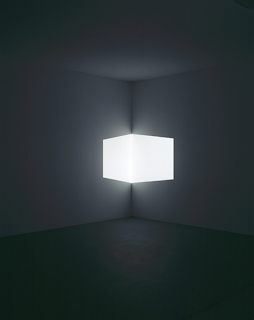 |
| Thomas Moran, "Under the Red Wall," Allartclassic.com |
This phrase, American Sublime, has caught the attention of poets and essayists alike. A poem by Wallace Stevens, titled "The American Sublime," has these lines:
How does one standxxx
To behold the sublime,
To confront the mockers,
The mickey mockers
And plated pairs?
 |
| Sidney Laurence, "The Silent Pool," Wikipedia |
But what intrigues me is that there's also an art movement by this name and that an art movement called Light and Space, which included Op Art, followed the tradition established by the American Sublime, which was mainly landscapes produced from 1820 to 1880. Three examples are shown throughout this post.
xxx
 |
| Thomas Moran, "Hot Springs of the Yellowstone," Google_Art_Project |
Even more intriguing is the work of artist James Turrell. Richard Lacayo, writing for Time Magazine, in the article (for subscribers only), "Prince of Light," brings all this jabber about art movements together nicely:
By the time he graduated in 1965 with a degree in perceptual psychology, the SoCal art scene was giving birth to the Light and Space movement. Artists like Robert Irwin, Maria Nordman and Douglas Wheeler were using light itself as their medium. In the process they were writing a new chapter in the long tradition of the American Sublime, the sense of awe before the bright dynamos of nature, conveyed largely through the sheer radiance that courses through American painting from 19th century landscape artists like Albert Bierstadt and Martin Johnson Heade to wide-screen abstractionists of the 20th century like Jackson Pollock and Barnett Newman.Turrell's works centers on a fascination with light itself:
But it may be that not since God has anyone given so much thought to what light is and what can be done with it. Though Turrell's art doesn't insist on, or even encourage, spiritual interpretation, some of his earliest encounters with the idea of illumination came by way of his Quaker upbringing in Pasadena, Calif. The Quaker way of characterizing meditation as "going inside to greet the light" intrigued him. And as a native of sunny Southern California, he knew all about the light outside. Painting had always been in large part about the representation of light. Turrell wanted to drink from the tap. At art-history slide lectures at Pomona College in the early 1960s, he was as fascinated by the beam from the projector as he was by the slides. Maybe more. (Lacayo, Time Magazine)And thus, in this one last quote, we come to what his art is about:
Turrell aimed to make art in which not just light but perception itself was his medium--the viewer's perception--works that prompt you to examine the very act of seeing as you do it.So what does his work look like? Basically you have to walk through it and experience it. This image shows one of his earlier works and was produced by beam of white light projected into a darkened corner:
xxx
 |
| James Turrell, SFAQ |
-- Marge

No comments:
Post a Comment